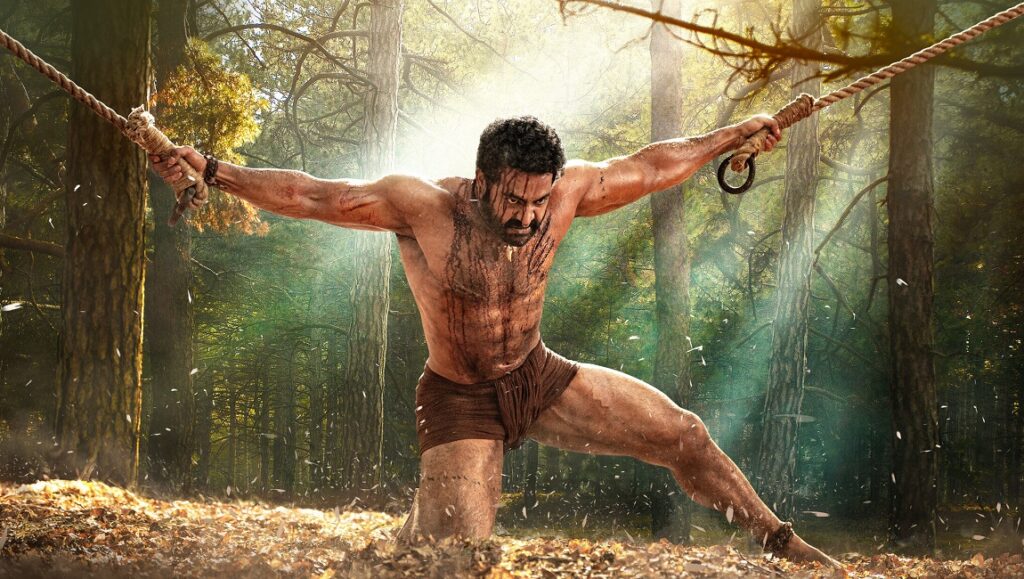RRR once again proves that Rajamouli and co. are virtually unmatched in viscerality and clarity of visionary spectacle.
S.S. Rajamouli’s latest epic RRR begins with perhaps the most unexpected first song possible. A young girl, Malli (Twinkle Sharma), is singing to Catherine Buxton (Alison Doody), the wife of a Delhi governor (Ray Stevenson) who is visiting the Gond tribe in a forest located in the modern state of Telangana. After being charmed by this plaintive voice, the Buxtons trick Malli’s family into selling her as a plaything, severely beating her mother when she tries to resist. This, as the first of the three title cards that makes up RRR’s title helpfully points out, is The StoRy: a colonial force brutally asserting its force and power over the native people, with Malli’s innocence both registering strongly on an individual and a national, allegorical level. But such an appellation is as much pretext as it is the driving force for the narrative: the film quickly becomes the story of two real Telugu revolutionaries in an imagined account of a friendship that the two formed in the 1920s — Komaram Bheem (N. T. Rama Rao Jr.) and Alluri Sitarama Raju (Ram Charan).
The two are presented, at least initially, as literally elementally opposed forces: Raju is introduced as The FiRe, first seen as a police officer fighting through literally hundreds of people to capture an Indian man for a superior, while Bheem is The WateR, whose opening scene finds him trapping an enormous tiger. At first glance, this appears to be the central conflict of the film, with Bheem, the tribe’s protector, attempting to rescue his lost lamb while Raju, the traitor cop, attempts to find the “outsider” in the teeming throngs of Delhi. But after an extraordinary sequence that finds the two of them meeting and then saving a boy caught in the water below a train derailment by jumping over a bridge and wrapping themselves in an Indian flag to avoid the flames, the title card, 30 minutes in, at last comes in and the entire dynamic shifts.
RRR — which doesn’t stand for anything, as Rajamouli chose to use a title that could appeal to as wide an audience as possible given the grand sweep of the narrative; the fan-contest winner in Telugu was Raudraṁ raṇaṁ rudhiraṁ, which translates to Rage War Blood — thus presents a title, and a narrative, that is both united and divided. The two men, who clasp hands both in the air and underwater, quickly become best friends, sharing an interest in general frolicking and their impossibly productive workout regiments, while they both continue with their missions. The first revelation of their identities and perceived betrayals on both their parts comes to head at the final scene before the InteRRRval, during Bheem’s chaotic assault on the governor’s palace, before it is revealed that Raju actually joined the police force to obtain weapons for his own state’s revolution against the British.
The cascading revelations about Raju and their effect on Bheem introduce an interesting, fitting balance of motivations. Bheem is never anything other than himself, a principled and kind man who will nonetheless do anything it takes to bring the tribe’s daughter home, while Raju’s character is complex and conflicted, equally committed to his ultimate cause though it requires active participation in the subjugation and maiming of his own people. But such concerns, and how they dovetail into the wider portrait of betrayal and redemption, arise just as much out of the time spent with building brotherhood as it does in the gloriously artificial action sequences.
RRR is truly a packed film, but its 182 minutes never feel unjustified, and while the character relationships are simple and almost preordained from each character’s first appearance — especially with Jenny (Olivia Morris), the One Good British person who Bheem falls in love with, and Sita (Alia Bhatt), Raju’s fiancée — much of the pleasure of the film comes from the slow assemblage of every piece into place. It might be a machine, but it is one of magnificent intricacy and care; even the obvious CGI enhancements — including the wholly artificial animals — retain a great impact because of their firm grounding in real bodies and choreography. (It should be noted here that others more knowledgeable in the field have written about the potential use, whether intentional or not, of the film to support the fascist Hindu nationalism of Modi, though all antagonism in the film is directly squarely toward the British colonizers.)
Any accurate survey of RRR inevitably (and rightly) devolves into a recounting of the most memorable set-pieces that Rajamouli crafts with swooping cameras, exaggerated angles, and rhythmic editing: the song “Naatu Naatu,” which begins as a rebuke to English pretentiousness at a party, becomes a joyous competition between men and women alike to see who at the dance will be the last one standing; a prison break that involves Raju dual-wielding rifles while sitting on Bheem’s shoulders; the sheer chaos of the raid on the palace, with so much action going on in the background as Bheem and Raju face off with hose and torch in hand, respectively. But other things stick just as vividly in the mind: the defiance of Bheem as he is lacerated by a spiked whip, his refusal to kneel inspiring the crowd of Indians to stampede the guards; the improbable spectacle of the governor being launched from his car and firing his rifle in mid-air; Raju maintaining his figure while in prison with through strenuous exercise, even as he is being starved. RRR’s rousing narrative derives its power equally from its central supermen, so incredibly statuesque and charismatic, and its feel for communal action, each scene another cog in this tale of sacrifice and resistance. In terms of sheer spectacle in the current landscape, Rajamouli and his collaborators are nigh unmatched in viscerality and clarity of vision.


Comments are closed.